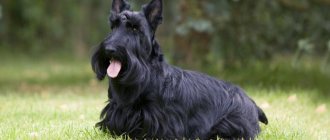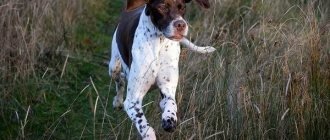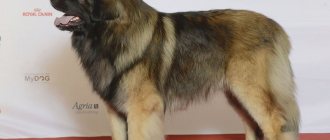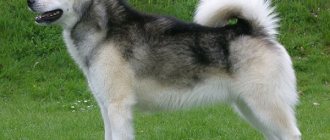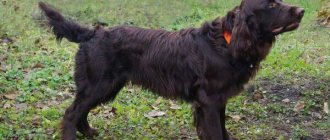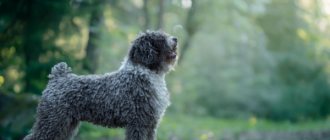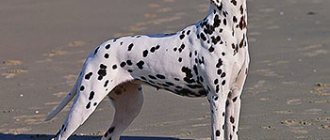Origin
The origin of this variety of bulldog is attributed to Pakistan, which is not far from the truth. The first mentions of gul dong at the end of the 19th century referred to the territory of this country. However, technically, the territory of modern Pakistan was considered an Indian colony, which means it makes sense to say that the origin of the dog has Indian roots.
It is difficult to find out the exact history of the origin and selection of fighting bulldogs due to the narrowness of their distribution area. Gul dong can be found in Pakistan, India, Iraq and Afghanistan. The ancestors of the Gul Dong are considered to be the Pakistani Mastiff (Bully Kuta) and the Pakistani Fighting Terrier (Gul Terrier). A number of sources mention the Dogo Argentino, the Old English Bulldog and the Bull Terrier. The selection principle was characterized by four main cherished qualities: power, speed, agility and aggressiveness. The breed has not received recognition from cynological associations around the world.
Dimensions, appearance
Cynological associations do not recognize the existence of such a breed as the guldog. Therefore, there is no point in talking about breed standards. The selection of individuals for mating is carried out according to the same four parameters: power, speed, agility, aggressiveness.
An adult male reaches 70-80 cm at the withers, a female's height is 60-70 cm. The tallest recorded height of a ghoul dog is 116 cm. The weight of an adult dog ranges from 35 to 60 kg. Sources call the specimen weighing more than 95 kg the most massive dog of the breed. The body structure of females and males does not differ significantly.
Body structure
The body is proportional with pronounced muscles.
Powerful long neck, large head, sometimes seeming disproportionately large in relation to the body.
The Pakistani has a long tail, which is docked for puppies intended for fighting. Even the undocked tail of the Gul Dong does not rise high.
The coat is short and harsh. The color is varied (white, black, red, gray, solid, with stripes or spots). The most popular dogs are those with light coats. The short, hard coat lies closely to the skin.
The paws are long, powerful, without curvature.
Muzzle
Broad forehead. The transition from the forehead to the muzzle is small and weakly expressed. The mouth has folds of skin. Ears are floppy from birth. Most representatives of the breed have their ears cropped during puppyhood. Cropped ears stand upright.
The almond-shaped dark eyes are distinguished by a wide set on a short muzzle with a rounded nose, often fully pigmented or in small spots.
The jaw muscles are highly developed. The jaw bones are powerful, massive with large, strong fangs. When closed, they form a correct scissor grip.
Features and character of the bandog
The Bandog's pedigree includes the American Pit Bull Terrier, Staffordshire Terrier and Neapolitan Mastiff, famous since the Crusade. The breed was originally created for dog fighting and hunting large animals. The inherited agility, fearlessness, tenacity inherent in the pit bull, power, extraordinary muscles, and guardian instinct from the Neapolitan mastiff converged in the appearance and nature of the bandog.
His activity, turning into rage, distinguished the dog during the period of bloodthirsty fights. The gladiator dog was fierce, merciless and uncontrollable in fights with bulls and other dogs. But after a hurricane attack, the dog succumbed to the growing power of the pit bull terrier.
The structure of the body and the characteristics of the nervous system at a certain stage prevented the continuation of the fight. So the breeders’ idea of a killer dog was not always justified.
Unlike the American breed, the Australian Bandog was bred exclusively for peaceful purposes: for protection, guard work and to serve as a reliable companion to active owners.
The time has come for bans on dog fighting, the retraining of the breed for security purposes has begun - to protect houses and property. Foxes and badgers often visited farmers' homesteads to steal away small livestock.
It is not easy to cope with them; in a situation of threat, the animals are unusually aggressive, not every dog is able to defeat these thieves. Bandog did an excellent job with this task. Now strong-willed dogs are used as guards, companions, bodyguards, and in special cases they are trained to work in law enforcement agencies.
At the beginning of the 18th century, dog fighting became popular. Therefore, new breeds appeared, specially bred for such purposes, and old ones that already existed were improved. This is how fighting breeds appeared, although dog handlers do not have such an official term. Most breeds survived even after the ban on dog fighting and became reliable guards and companions. This article contains a list of the most powerful fighting breeds.
The breed was developed in the 16th century in England, where there were many fans of dog fighting. Then, together with the settlers, it came to America, where it was developed and improved for a long time. They were bought for protecting houses and hunting big game.
This is a powerful dog with well-developed muscles; individuals are often thin. The head is wedge-shaped, scissor bite. Ears are sometimes cropped. Pit bull terriers weigh up to 27 kg. And they are up to 42 cm tall.
The energy they have a lot of makes pitites actively explore nature, play with their owner, and willingly carry out his commands. It depends on the owner of the dog what kind of dog it will grow up to be.
The Pit Bull Terrier is easy to train and is capable of performing the most difficult tasks. But to cope with the upbringing and training of a Pit, you need to have a strong character.
In many countries of the world this dog is prohibited for breeding and keeping. Some countries have introduced a special, fairly high tax for owners of this breed.
Character traits
The Pakistani bulldog is distinguished not only by its intelligence, cunning, stubbornness, but also by its devotion to its owner and his family. This fact does not diminish the danger of the breed to others. Gul dogs are dominant dogs with increased aggressiveness that require specific training by an experienced dog handler.
As soon as the owner of the Pakistani dog gives up the dominant position of the “leader of the pack” a little, the dog will not hesitate to show aggression and attack the “weakened leader.” The appearance of a stranger on the territory of the gul dong, noise, bustle, other animals and any other irritants will provoke an immediate attack.
Pakistanis are not adapted to urban conditions and living in an apartment. Temperamental dogs are constantly looking for a point of application of boiling energy, because, deprived of fighting practices, they remain excellent watchmen and security guards. Gul dong is suitable for keeping in an enclosure in a village or small settlement with a large local area. In any case, representatives of the breed need to exercise a lot during the day. Walking a gul donga is not a leisurely walk, but a jog at a good pace or a bicycle cross.
Character
The Gul Dong cannot be considered a family dog. It is not recommended as a pet for families with children. The owner of such a powerful dog must be an unshakable authority in its eyes.
It is important that a Pakistani considers all family members stronger than himself. If this does not happen, it is not recommended to leave him, for example, with a child or an elderly person alone without the presence of the owner.
With proper upbringing, a bulldog can become a reliable bodyguard and watchman. But around such a dog you always need to be on guard. If he doesn't like someone or something, he will attack without warning. Even a very strong person will not be able to repel the attack of a huge dog. This is why control of the gul dong is so important.
Relationships with children do not work out. Moreover, close contact between a child and a bulldog should not be allowed. The dog is completely unsuitable for games. The dog can respond to children's pranks with aggression, which will lead to tragedy.
The Pakistani Bulldog is 100% owner owned. You can’t even take a toy from him, let alone a piece of meat. He is ready to fight any opponent for his own. This quality makes him an ideal watchdog.
It is difficult to get along with pets. Shows aggression towards other dogs, sometimes unbridled. Therefore, only a physically strong person should take the dog out for a walk. In general, it is not recommended to keep other pets in the same territory as a Pakistani.
Looking at Gul Dong, he never seems to relax. Constantly collected and ready to attack. It is not for nothing that he was ranked among the most dangerous dog breeds in the world.
Training
Two important points of training are dominance and socialization. Gul Dong puppies raised in isolation from people and other animals are as aggressive as possible. Socialization should begin at a very early age and continue throughout the dog's life.
Wayward Pakistanis occupy dominant positions in the dog hierarchy. This must be taken into account by the owner, who will have to train himself, because the owner must literally suppress the will of the dog.
A beginner in the field of cynology and training risks his life and health by acquiring a representative of the gul dongs. The most insignificant nuance in relations with an animal or the slightest indulgence can cause a loss of authority in the eyes of a Pakistani and provoke an instant attack.
For example, when walking, a Pakistani bulldog should always be at least one step behind its owner. From puppyhood, the dog must be constantly monitored and in contact with it, in order to avoid the same loss of authority.
Learning ability
Gul-dong is a difficult animal to train . For good adaptation and if you want to have him in a city apartment, you need to train him from a young age. Only a few people get such a dog; not all experienced dog handlers agree to have a time bomb at their side.
In order for the class to go perfectly, it is worth letting the puppy know who is in charge. Otherwise, he will become not a companion and subordinate, but a willful master of the house. Everyone at home will have to adapt to his mood.
When training him, it is necessary to conduct such classes every day and throughout his life. Then the acquired gul-dong knowledge will be easy to put into practice.
Breeders complain that neglected dogs can only occasionally follow orders, reacting most to commands: “Fu,” “stranger,” “guard.”
Maintenance and care
Gul dongs are unpretentious in maintenance and require only a minimum of sanitary procedures. It is necessary to wash the dog completely no more than 1-2 times a year. Short hair does not need a hair dryer; exposure to a stream of warm air can even cause drying of the skin.
Grooming involves combing with a thick rubberized glove in the direction of hair growth up to 2 times a week.
Cleaning the eyes with a cotton pad soaked in warm water is done as needed.
Once a week it is necessary to treat the ears of a Pakistani bulldog with a cotton pad soaked in hydrogen peroxide.
Claws should be trimmed with special pliers once every two weeks to a month.
Cleaning with a special fingertip and toothpaste every 3 days will help prevent problems with teeth and the appearance of plaque.
Health
Dogs of this breed have good health and strong immunity. Their life expectancy is on average 13-14 years. However, due to their involvement in fighting, these dogs rarely live to this age. They usually die from their wounds and injuries.
Caring for the health of these dogs involves routine vaccination and treatment for parasites. In addition, it is necessary to take your pet to a veterinary clinic once a year for examination.
These dogs have problems mainly only with the ears and teeth, on which tartar forms. Therefore, it is important to carefully monitor their condition.
Nutrition
Keeping a Gul Dong dog is not cheap. The powerful muscular frame of the Pakistani needs constant replenishment with protein. When purchasing a dog, you need to make a choice in favor of natural food or dry food, and not mix these food lines in the future.
Natural food
The Pakistani Bulldog eats about 3 kg of meat during the day. The basis of the diet is:
- Lean meat and fish;
- Giblets;
- Broths based on meat and fish, soups based on them;
- Porridge to provide the body with fiber;
- Fermented milk products: cottage cheese, kefir, yogurt;
- Fresh vegetables to maintain vitamin balance.
Dogs are prohibited:
- Fat meat;
- Bones;
- Bread products;
- Legumes, corn, onions, potatoes;
- Sweet, salty, sour, bitter, pickled, fried, smoked food.
Dry food
Dry food should satisfy the Pakistani Bulldog's body's need for proteins and vitamins. Gul dong needs a quality product. The daily amount of food should be selected based on the needs and age of the dog, as well as the composition of the food.
Regardless of the type of food, a Pakistani needs constant access to plenty of drinking water and periodic use of vitamin complexes.
Diet for an adult dog (from six months): 1-2 times a day. Malnutrition is most pronounced in the lower ribs. If the lower costal arches begin to bulge, the dog needs to increase the amount of food.
Breeding and cost
As was written above, dog handlers do not recognize the Gul Dong breed, therefore, it is impossible to get a puppy or an adult dog in an official kennel, since such establishments, registered in full form, simply do not exist in nature. This is not a surprising fact, given that in many countries the breeding of such fighting dogs is prohibited.
Breed standards and breeding of dogs are carried out in their historical homeland - Pakistan and India. Distinguishing a Pakistani puppy from a Dogo Argentino or Bully Cutt puppy is a task for a professional. As a rule, when making such a choice, reference is made to the structure of the paws and the power of the bite.
Gul Dong puppies are sold much cheaper than adults. A small representative of the breed will cost from 5 to 11 thousand rubles. An adult, trained and trained dog will cost at least 35 thousand rubles, which is an impressive amount in Pakistan.
History of the breed
It is impossible to calculate how many dog breeds there are in the world. Experts talk about more than 400 officially registered species. There is a special group of animals that remains outside the classification of cynologists. These are aboriginal dogs - the most ancient inhabitants of the planet among their relatives, who have an incredibly strong genetic memory from their wild ancestors. These include the Pakistani bulldog, or mastiff - gul dong.
Gul dong
The breed was developed in the 19th century in Pakistan, which was then part of colonial India. The “parents” were the Bully Kutta (Pakistani mastiff) and the Ghoul Terrier, which is similar in appearance to the English Bull Terrier and Dogo Brasil. The latter came to Pakistan during the time of British expansion into India.
In an economically backward country, crude selection was practiced in artisanal conditions. Weak cubs died, the strongest had the right to life. Two centuries ago, Pakistanis did not care about the socialization and legal integration of dogs into society. There were no nurseries for breeding the breed, as there still are none, so it is impossible to trace the pedigree.
Gul dong with the owner
The result of crossing the bloodthirsty bully cutta and the brave ghoul terrier was a beautiful, strong breed - the dog fighting gladiator gul dong. In the arenas that still exist underground in Pakistan, the opponents of the gul dongs were wild predators (bears, wolves), bulls and dogs of other breeds
No one stood a chance against the fearless fighter.
Note! The owners made a lot of money, purebred puppies were expensive. Only a very rich person could afford to buy an adult
Summing up
Dogs of the Ghoul Dog breed are aggressive, cunning and intelligent. For an owner who has managed to properly socialize and raise a Pakistani dog, and is also able to constantly maintain his authority as the “leader of the pack,” a powerful dog will become an excellent watchman and protector.
However, in the hands of an inexperienced dog breeder, a Pakistani bulldog will be dangerous not only for surrounding animals and household members, but also for the owner himself. Before choosing a pet of this breed, you should soberly assess all the risks of owning a difficult-to-train dominant fighting dog.
